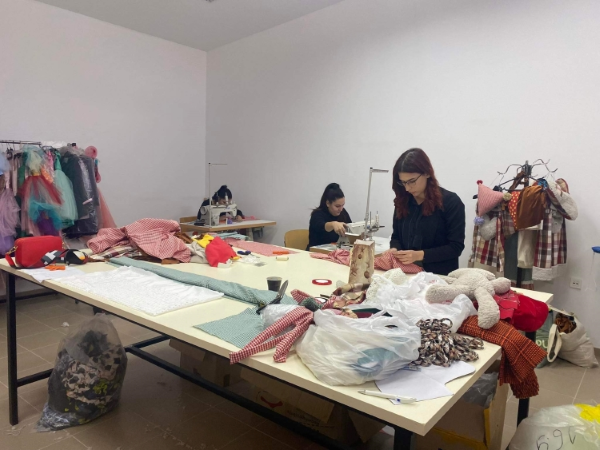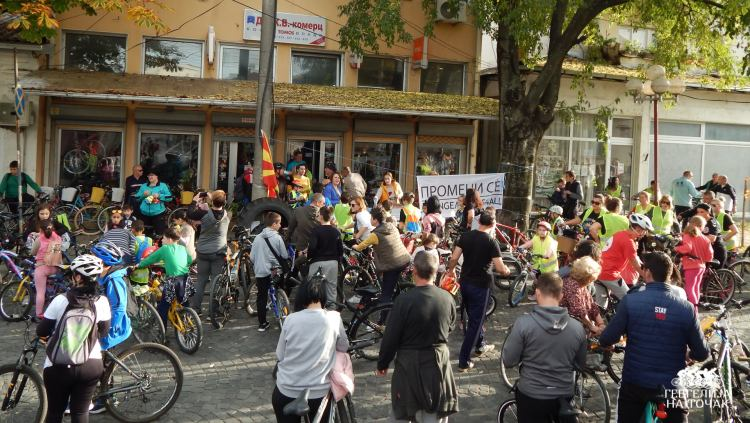Pillows, quilts, lazy bags, but also pieces of clothing that dominate the fashion runways… You will hardly recognize them in the piles of textile waste, but it is still there.

From a problem, from a polluter to the environment, part of the textile waste is transformed into a product with a new value. In the absence of a systematic solution for textile waste, pioneering steps in this direction are being made by the non-governmental and higher education sectors. The non-governmental organization Local Community Development Foundation (FRLZ) from Shtip together with the Faculty of Technology at the State University Goce Delchev demonstrated in practice how textile waste can be a raw material instead of a pollutant and be processed:
“We collect textile waste, but not the one that is declared to customs, but the one that remains from the tailor’s shop, we process it, and use it as filling for cushions – decorative for sitting. Now we are also introducing two new products, pet pillows and children’s dolls.
Macedonia deposits 9000 tons of textile waste per year, which is later burned at landfills and by that pollute the air
At the national level, some 9000 tons of textile waste annually (State Statistics Office), end up at landfills, where it is burned, and additionally pollutes the air.
“We feel the consequences of textile waste a little later, not at the moment when it is created,” says Assoc. prof. Sanja Risteski, PhD, professor at the Faculty of Technology.
The first project had begun, in 2021, titled as “The circular economy as a way to deal with textile waste”, because the circular model itself offers exactly that – we have a resource, from that resource we create a product, the production process generates textile waste, but instead of ending at landfills and considered as pollutant, we use that textile waste as a raw material for obtaining a new product.
“The goals were to make pillows, lazy bags or seat pillows, quilts in different sizes.
This is just one of the possible solutions for textile waste. This solution has its own additional value by involving vulnerable groups of citizens. Jobless women who lost their jobs in the textile companies, other vulnerable groups can find their own role in working with textile waste. That is why we worked with sensitive, vulnerable groups of citizens. The first training was implemented with the center “Poraka”. People with special needs were engaged, and we have successfully redesigned the waste from textile companies in T-shirts, bags…”

People with disabilities and workers who lost their jobs are active again in processing textile waste
Another training took place at the Iskra secondary school for education and rehabilitation in Shtip. The pupils made beautiful creative works. These pupils are already skilled in sewing, constructing, and modeling, so a lot of models came out from there. It is with great pleasure to say that in the process of re-modelling and preparation of different products a large amount of textile waste has been used.
About one hundred participants passed through these trainings – pupils, students, people with special needs, as well as women from textile companies who lost their jobs. Part of the students that were involved in this process were from Spain, having their Erasmus+ exchange program.
Social entrepreneurship in our country is at the beginning, and how realistic is it to expect rapid growth of social enterprises that will deal with textile waste, we ask Sanja Mancheva, co-founder and president of the Association for Education, Promotion and Development of Social Entrepreneurship KO- CREATORS, mentor in Regional Incubator for Social Entrepreneurs RISE and Eptisa South-Eastern Europe – regional office for social economy.
Several success stories are proof that social enterprises can survive
“Social entrepreneurship occurs with the need to create a new concept different from humanitarian actions and providing assistance to marginalized communities. The idea was for the communities’ members to become actively involved in finding solutions to the challenges they face. Furthermore, to change their place in the Eco-system from people who receive help, as business owners or employees in enterprises with social missions, helping solve social problems. Every third newly opened enterprise in Europe is social, but in our country social entrepreneurship is still in the development stages, although it has seen great progress in the past years.
The reasons for this situation are the numerous challenges faced by people who could or would like to start social businesses, but one thing is certain, it is not due to the absence of needs for their existence. To encourage the development of this enterprise concept, more education and mentoring of all stakeholders in society, special local and national policies, keeping in mind all territorial challenges and needs, are needed.
To develop a sustainable social enterprise, which has proven to be the biggest challenge from the practice so far, the social and economic mission should come from the community we want to support and strengthen, to respond to the needs of the concerned people, but also the needs of the territory. The success stories of Umbrella Lounge Bar, Pokrov, Kopce are just a few examples that even in these spaces social enterprises can survive. Needs, interests and ideas exist. Education, mentoring and support is what is missing”.

The Shtip landfill is constantly on fire
Support from the state – crucial for social entrepreneurs who want to process textile waste
Boris Sharkovski from FRLZ says that the biggest problem for the functioning of such social enterprises is that there is no incentive from the state. Also, there is not enough entrepreneurial spirit among potential entrepreneurs. Initial capital is difficult to have, there are no funds, and the new law, instead of facilitating the work, is in danger of imposing new administrative difficulties.
However, as in many other areas, and with the issue of textile waste, a significant part of the solution to the problem lies with the people, the individual. In this case, this is mostly reflected in the old clothes, which we all throw away and end up in waste, on the landfill and are later burned.
Old clothes instead in container, in collection centers
There is a worldwide tendency for enormous increase in cloth production. That means more is bought and worn for a shorter time. Full wardrobes are a problem for us, and we get rid of old clothes in the simplest way – we throw them in a container. Thus, it only increases the amount of textile waste and air pollution. The solution is to donate the clothes, or to deliver old cloths through collection centers for old clothes, usually at the Red Cross.
The legal amendments also provide solutions for old clothes:
We all have clothes we don’t need. Before we throw it away, we should consider whether we can redesign it and create a new piece of clothing.
The activities of FRLZ go in the same direction, confirms Boris Sharkovski:
We will focus more on reuse and recycling of used clothes. All this is in the context with the provisions of the new Law on Waste Management”.
The production of new products from textile waste through Social Enterprises is one of the possible solutions for this pollutant. Of course, this is a good start for engaging the textile companies for whom textile waste is a problem, but also for the institutions, which should look for solutions to reduce environmental pollution.




